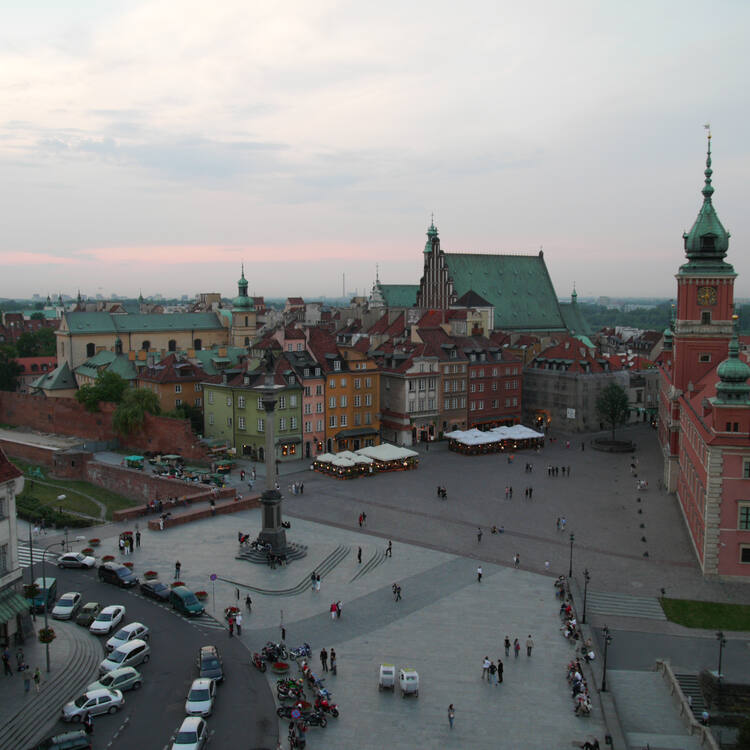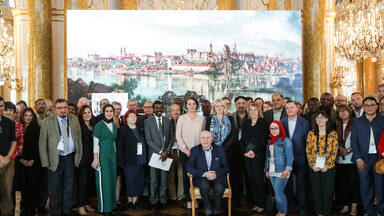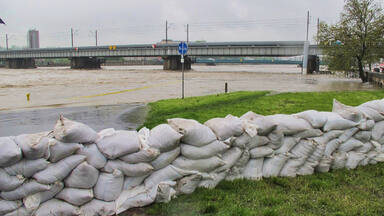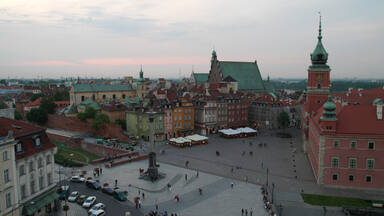Historic Centre of Warsaw
Historic Centre of Warsaw
During the Warsaw Uprising in August 1944, more than 85% of Warsaw's historic centre was destroyed by Nazi troops. After the war, a five-year reconstruction campaign by its citizens resulted in today's meticulous restoration of the Old Town, with its churches, palaces and market-place. It is an outstanding example of a near-total reconstruction of a span of history covering the 13th to the 20th century.
Description is available under license CC-BY-SA IGO 3.0
Centre historique de Varsovie
En août 1944, pendant le soulèvement de Varsovie, plus de 85 % du centre historique de la ville ont été détruits par les troupes nazies. Après la guerre, ses habitants ont entrepris une campagne de reconstruction sur cinq ans, avec pour résultat une restauration méticuleuse des églises, des palais, et de la place du marché de la vieille ville. C'est un exemple exceptionnel de reconstruction quasi totale d'une séquence de l'histoire (XIIIe-XXe siècle).
Description is available under license CC-BY-SA IGO 3.0
وسط وارسو التاريخي
في آب أغسطس من العام 1944، وفي أثناء الانتفاضة في وارسو، دمّرت الفرق النازية أكثر من 85% من الوسط التاريخي للمدينة. وبعد انتهاء الحرب، قام السكان بحملة اعادة بناء امتدت على فترة 5 سنوات كانت نتيجتها ترميم دقيق للكنائس والقصور وسوق المدينة القديمة. انه مثال استثنائي لإعادة البناء شبه التامة لحقبة من التاريخ (القرن الثالث عشر حتى القرن العشرين).
source: UNESCO/CPE
Description is available under license CC-BY-SA IGO 3.0
华沙历史中心
1944年8月华沙起义期间,华沙历史中心85%以上的建筑遭到纳粹部队的摧毁。二战之后,华沙人民用长达5年的时间重建古城,他们修建了教堂、宫殿和贸易场所。华沙的重生是13世纪至20世纪建筑史上不可抹灭的一笔。
source: UNESCO/CPE
Description is available under license CC-BY-SA IGO 3.0
Исторический центр Варшавы
Во время Варшавского восстания в августе 1944 г. более чем 85% исторического центра Варшавы было разрушено нацистскими войсками. После войны, в ходе пятилетней кампании по восстановлению Варшавы ее жителями, Старый город с церквями, дворцами и Рыночной площадью был тщательно отреставрирован. Это - выдающийся пример почти полного воссоздания городского облика, формировавшегося в период с XIII в. по XX в.
source: UNESCO/CPE
Description is available under license CC-BY-SA IGO 3.0
Centro histórico de Varsovia
El centro histórico de la capital polaca fue destruido por las tropas hitlerianas en más de un 85% en agosto de 1944, durante la insurrección de sus habitantes contra el ocupante nazi. Después de la guerra, una campaña de reconstrucción de cinco años, llevada a cabo por los propios varsovianos, dio como resultado la restauración meticulosa de sus iglesias y palacios, así como de la plaza del mercado de la ciudad vieja. El sitio es un ejemplo único de reconstrucción prácticamente total del conjunto de un patrimonio arquitectónico histórico de los siglos XIII a XX.
source: UNESCO/CPE
Description is available under license CC-BY-SA IGO 3.0
ワルシャワ歴史地区
source: NFUAJ
Historisch centrum van Warschau
Meer dan 85% van het historisch centrum van Warschau werd door nazitroepen vernietigd tijdens de Opstand van Warschau in augustus 1944. Na de oorlog hebben de burgers van de stad vijf jaar lang een reconstructieplan uitgevoerd. Het resultaat is de huidige uiterst precieze restauratie van de oude stad, met zijn kerken, paleizen en marktplein. Het is een goed voorbeeld van een bijna volledige reconstructie van de geschiedenisspanne van de 13e tot de 20e eeuw. Het historisch centrum toont een mix van verschillende stijlen – van gotiek tot barok – en bijna elk gebouw in de oude binnenstad heeft een unieke architectonische stijl.
Source: unesco.nl
Outstanding Universal Value
Brief synthesis
Warsaw was deliberately annihilated in 1944 as a repression of the Polish resistance to the Nazi German occupation. The capital city was reduced to ruins with the intention of obliterating the centuries-old tradition of Polish statehood. The rebuilding of the historic city, 85% of which was destroyed, was the result of the determination of the inhabitants and the support of the whole nation. The reconstruction of the Old Town in its historic urban and architectural form was the manifestation of the care and attention taken to assure the survival of one of the most important testimonials of Polish culture. The city was rebuilt as a symbol of elective authority and tolerance, where the first democratic European constitution, the Constitution of 3 May 1791, was adopted. The reconstruction included the holistic recreation of the urban plan, together with the Old Town Market, townhouses, the circuit of the city walls, the Royal Castle, and important religious buildings.
The reconstruction of Warsaw’s historic centre was a major contribution to the changes in the doctrines related to urbanisation and conservation of cities in most of the European countries after the destructions of World War II. Simultaneously, this example illustrates the effectiveness of conservation activities in the second half of the 20th century, which permitted the integral reconstruction of the complex urban ensemble.
The reconstruction of the Old Town was a coherent and consistently implemented project devised at the Warsaw Reconstruction Office in the years 1945-1951. The reconstruction project utilised any extant, undamaged structures built between the 14th and 18th centuries, together with the late-medieval network of streets, squares, and the main market square, as well as the circuit of city walls. Two guiding principles were followed: firstly, to use reliable archival documents where available, and secondly, to aim at recreating the historic city’s late 18th-century appearance. The latter was dictated by the availability of detailed iconographic and documentary historical records from that period. Additionally, conservation inventories compiled before 1939 and after 1944 were used, along with the scientific knowledge and expertise of art historians, architects, and conservators. The Archive of the Warsaw Reconstruction Office, housing documentation of both the post-war damage and the reconstruction projects, was inscribed in the UNESCO Memory of the World Register in 2011.
The rebuilding of the Old Town continued until the mid-1960s. The entire process was completed with the reconstruction of the Royal Castle (opened to visitors in 1984). The reconstruction of individual buildings and their surroundings, in the adopted format of residential housing, featuring public functions dedicated to culture and science, as well as services, carried with it numerous challenges posed by the need to adapt to the social norms and demands of the time. In order to accentuate the defensive walls and the city panorama as viewed from the Vistula, the reconstruction of some buildings was deliberately foregone. The urban layout was retained, along with the division of the street frontages into historic building plots; however, the properties within these quarters were not rebuilt, thus creating communal open areas for residents. The interior layout of buildings and residential flats was revised to meet the standards in force at the time. However, both historical room plans and interior designs were recreated in many of the buildings intended for public use. A highly regarded feature was the decoration of exterior elevations carried out by a team of renowned artists, who drew in part on designs from the interwar period. Polychrome decoration was executed using traditional techniques, including sgraffito. In spite of the adaptations and the changes introduced, the site, along with the city panorama as seen from the Vistula (which has become a symbol of Warsaw), presents a cohesive picture of the oldest part of the city.
Combining extant features with those parts of the Old Town reconstructed as a result of the conservation programme led to the creation of an urban space unique in terms of its material dimension (the form of the oldest part of the city), its functional dimension (as a residential quarter and venue for important historical, social, and spiritual events), and its symbolic dimension (an invincible city).
Criterion (ii): The initiation of comprehensive conservation activities on the scale of the entire historic city was a unique European experience and contributed to the verification of conservation doctrines and practices.
Criterion (vi): The Historic Centre of Warsaw is an exceptional example of the comprehensive reconstruction of a city that had been deliberately and totally destroyed. The foundation of the material reconstruction was the inner strength and determination of the nation, which brought about the reconstruction of the heritage on a unique scale in the history of the world.
Integrity
This World Heritage property’s boundaries encompass an entire comprehensively rebuilt portion of the city, located within the bounds of the medieval city walls and the Vistula Escarpment (including the eastern foot of this escarpment), with all of the characteristic features defining its identity. During the reconstruction, the original urban layout of the medieval city was preserved, and in some cases made more distinct. The principle of rebuilding and accentuating the historic layout was applied not only to the Old Town, but also to the buildings of the New Town and the Royal Route, which in effect created a sense of historical and spatial continuity within this urban complex (the aforementioned areas are located inside the limits of the buffer zone).
In order to maintain the integrity of this property, it is essential that the principles implemented during the process of reconstruction are maintained and continue to underpin the management system, and that the appropriate state of preservation and conservation of individual tangible and intangible elements of the complex, which carry Outstanding Universal Value, be ensured.
Maintaining the functional dimension of the Old Town as a residential quarter and venue for important historical, social, and spiritual events is a significant aspect of its integrity.
Authenticity
The cohesive rebuilding process came to an end with the reconstruction of the Royal Castle. Since then, the Historic Centre of Warsaw has fully retained its authenticity as a finished concept of post-war reconstruction. This World Heritage property includes two categories of structure. The first comprises extant structures predating the damage of World War II. This applies to most basements, some ground floor storeys and certain sections of wall up to the level of the first floor. The second category encompasses reconstructed features – this group includes buildings recreated in accordance with pre-war records (some of the Old Town’s townhouses, the Sigismund’s Column, churches, and the Royal Castle), and those rebuilt based on historical and conservation studies pertaining to the architecture of the 14th to 18th centuries (e.g. the façade of the cathedral, and the Old Town walls with the Barbican). The state of preservation of individual types of structure and entire buildings is satisfactory. Their maintenance requires the implementation of systematic conservation measures.
Protection and management requirements
The Historic Centre of Warsaw is an area subject to legal protection and conservation based on Polish legislation. Managing this area is the duty of the local government of the City of Warsaw. Management issues take into account the values and wishes of all stakeholders connected with the area.
The principal management tools are the Management Plan and the integrated spatial planning system, based on an agreed Local Spatial Development Plan. Outlining a buffer zone of significant value in terms of historical monuments protected on the basis of the city's spatial planning documents makes it possible to control the impact of the surroundings on this World Heritage property. The area is protected from potential threats by a system of problem identification and regular monitoring which assesses the state of preservation, ongoing conservation procedures, as well as urban, environmental, functional, and social changes.
Education and raising awareness of the significance of Warsaw’s reconstruction in the post-war history of Poland and Europe is an important aspect of effective management for the future of the property.

 View photos from OUR PLACE the World Heritage collection
View photos from OUR PLACE the World Heritage collection


